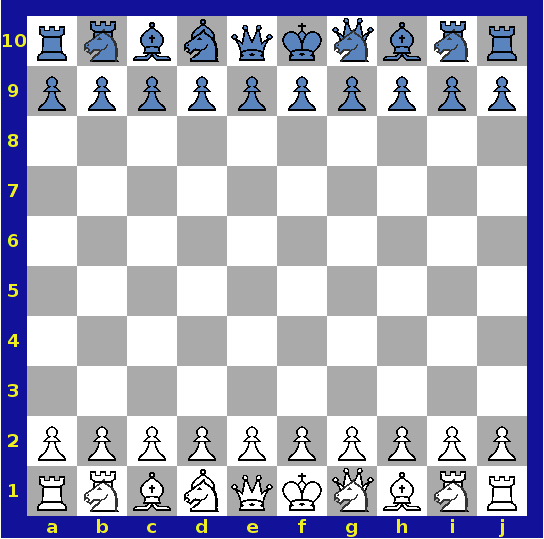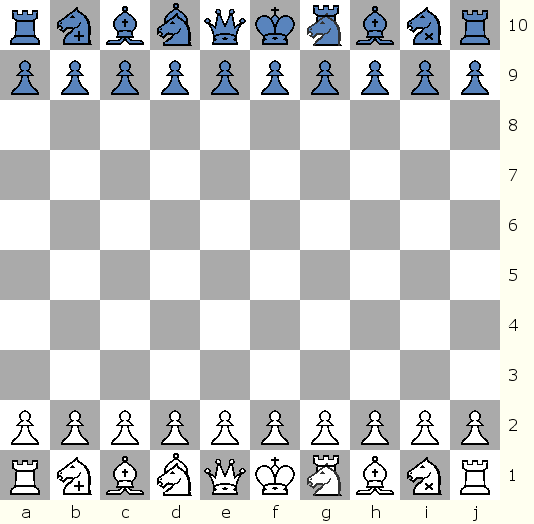Super Knights Grand Chess
Introduction
This exciting new variant is based loosely on the Capablanca Chess variant but with 3 new powerful pieces: the Super Knights!The inventor of this game, was playing around with the different variations of Capablanca Chess (of which Gothic Chess also belongs) and came up with an intriguing solution: Why not discard the regular knights, replace them with rook-knights (Chancellor, Marshall), add a bishop knight (Archbishop, Cardinal) and the very powerful queen-knight (Amazon, Terror) to the mix! Many of the problems associated with Bird's original setup as well as Capablanca's setup can then be avoided when set up as shown below.
Chess in the middle ages was much slower than the modern super queen chess we see now. With the dearth of opening theory now reaching saturation, why not expand the powers once more and continue the history of chess, introducing the period of SUPER KNIGHTS!
Note that in capablanca chess (and gothic chess too), the knights are the weakest pieces, and it seems that they are the most expendable pieces. The point though is if we have superknights why not drop the regular knights! And that is the essential difference between the 10x10 and 8X8 version of superknights and the variants of Capablanca chess.
In this new variation, the king is surrounded by a queen and a queen knight. He certainly is NOT monogomous! Notice that the queen knight now guards the naturally weak square f2(or f7 for black)! His favorite queen is the queen knight, but don't underestimate the power of the queen! The queen gets a bishop knight to balance her side of the board.
The three new super knights are:- A bishop-knight (Archbishop, Cardinal, Minister) with the enhanced powers of a bishop and knight. This piece is situated next to the queen on d1 or d10.
- Two rook-knights (Chancellor, Marshall, Empress) each with the enhanced power of the rook and knight. They are situated next to the rook for White on b1 and i1 or for black on b10 and i10.
- A very powerful Queen-knight (Amazon, Terror, General, Maharaja) with the combined powers of a queen and a knight. Situated on e1 or e10. This is a very powerful piece when brought into play.
 |
The board is set up as follows for the white side (black side will mirror this):
Rook on a1 Rook-knight on b1 Bishop on c1 Bishop-knight on d1 Queen on e1 King on f1 Queen-knight on g1 Bishop on h1 Rook-knight on i1 Rook on j1 10 pawns from a2 to j2. |
Rules
The rules in Super Knights Grand Chess are the same as in chess except for the following modifications:- Castling is done by moving the king three squares to the left or right and moving the rook next to it. For example, white can castle kingside (providing no other pieces are in between, and no squares over which the king travels are attacked) by moving his king from f1 to i1 and his rook from j1 to h1. On the queenside, white king moves from f1 to c1 and rook from a1 to d1.
- Pawn moves: The pawn can move from its original position either 1, 2 or 3 squares forward. Subsequently as in normal chess, it can only move 1 square forward. If a pawn moves 1 square forward from its original position, it loses its ability to move more than 1 square forward and can only move forward 1 square at a time.
- En Passant: If a Pawn moves two or three squares initially and passes an opposing Pawn on the fourth or fifth rank, the Pawn may be captured en passant. E.g. White pawn on a2 black pawn on b4. If the white pawn moves from a2 to a4 or a5, the black pawn on b4 can capture it as if it had moved to a3. Similarly, if the black pawn is on b5 instead and the white pawn moves to a5 from a2 then the black pawn can capture the white pawn as if it moved to a4. Note in this case the white pawn can still avoid the black pawn by moving to a3 instead.
Capturing en passant is optional unless it is the only legal move available. The capture must be made on the next move. - Pawn promotion: Pawns can now promote to: queen,queen-knight,rook-knight, bishop-knight, bishop.
New Strategical Points
- The most significant change in this variation is the relative power of the pieces. Rook-knights and bishop-knights are worth much more than bishops. A rook-knight is almost as powerful as a queen but not quite.
- No longer can you bring out your super-knights and invite pins from bishops. For example, a rook-knight being pinned by a bishop is highly undesirable since the pinned side will more than likely lose the exchange, giving up the rook-knight for a bishop. Note that the rook-knights are at the same start position as the knights in regular chess and can be pinned quite easily if used in the same fashion as in ordinary chess.
- The bishops are now the weakest pieces, but early in the game they can be used to harass any super knights on the board.
-
The larger board decreases the knight powers somewhat, but the enhanced power of each knight compensates for this.
Unlike normal chess, the knight moves alone do not have enough range to attack the pawns right away in the beginning. E.g. opening: f5 f6. No knight can be developed to attack these pawns. - The new knights must be moved with caution. On one hand, it would be ideal to make use of the knight's short range power and post these pieces near the center of the board. On the other hand, they are vulnerable to attack from bishops and must be able to escape from them.
- Each side now has 6 pieces that can move along files and ranks: the queen, queen-knight, 2 rooks and 2 rook-knights. The tactical possibilities for an attack on the back rank are now a lot more complex.
- Each side now has 5 pieces that move along diagonals with three pieces that can change diagonals: The queen,queen-knight and bishop-knight that can change diagonals, and the two bishops.
- Note that the king is between the queen and the queen-knight. There are no unprotected squares or very weak squares next to the king. Nonetheless, a quick attack can be built up to exploit any weaknesses created by your opponent.
Give it a try and see how it compares to the rest!
This 10x10 Chess variant was invented by Charles.
The game info was also submitted to the Chess Variants page.
View Game Logs - Sample Games Here!
Super Knights 2
 |
In Super Knights 2, the
Knights are replaced by the Ferz Knight and Wazir knight which make a diagonal step or an orthogonal step respectively in addition to their knight jump.
The board is setup as shown. The Standard Pawn (or Ninja Pawn) can move 1- multiple spaces towards the middle, after which they move 1 space forward per turn. During play, 5 Ninja Pawns can be dropped into an empty space ( 1 per turn) on 2nd rank and optionally pushed forward 1 or more squares to the middle. The Ninja Pawn is a special pawn that can move/capture like a regular pawn as well as move 1 space sideways. When in enemy half of board it can also capture 1 space sideways. Castling is flexible: The King can move 1-3 (4 on Q-side) spaces towards the Rook. |
|
If you would like to email the chess variant inventor directly: inventor@chess.computerwebservices.net
|
|
Posted by: Lolz on 2009-11-14 01:26:55 Like Chess: YES Lolz Posted by: vijaysai on 2009-01-23 22:27:39 Like Chess: YES i play chess very much Posted by: John on 2008-10-02 15:44:23 Like Chess: YES
I have to try this. |

